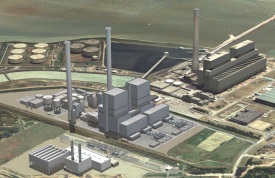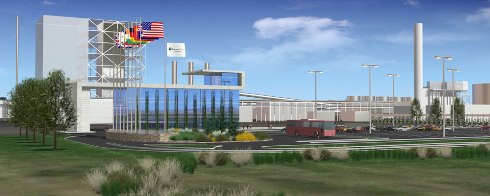Carbon capture at E.ON's Kingsnorth coal plant
 |
| E.ON's planned Kingsnorth supercritical coal plant |
E.ON’s plan to install supercritical coal-burning technology on its Kingsnorth site in Kent was (unsurprisingly) supported by the planning authority. A more interesting question is why E.ON persisted with the application in the first place. Even carbon efficient power stations emit far more carbon than gas plants. A high price of carbon would make the Kingsnorth coal plant uneconomic. The answer to the question must be that E.ON is confident that supercritical coal plants can be economically retrofitted with carbon capture technology (CCS). So even if the carbon price increases dramatically, coal will still be competitive.
E.ON’s US operation is closely aligned with the co-operative FutureGen venture, which plans to build a coal gasification plant in the US within five years. This power station will then capture CO2 and store it in sandstone. FutureGen gasification carbon capture technology is ‘pre-combustion’, unlike the ‘post-combustion’ focus in Europe. US electric utilities are now assuming that coal plants without CCS will not be allowed. But in both the US and Europe there seems to be a prevailing assumption that a $30 per tonne CO2 price is sufficient to cover the cost of CCS technology, meaning coal will eventually be back in the power station mix.
***
Kingsnorth power station is currently composed of two large coal-fired plants with two burners in each. With old technology, this power station would eventually have to have been closed under the EU’s Large Combustion Plant Directive. E.ON has applied to switch the plant to using supercritical coal technology, which substantially reduces emissions. A typical old coal plant will produce 850g of CO2 per kilowatt hour produced, but this is reduced to less than 700g for a new supercritical plant, saving 20% more of the carbon emissions.
Of course another benefit is that less coal is used. A new supercritical plant achieves 45% thermal efficiency compared to 36% at today’s Kingsnorth power station (45% means that just under half the thermal value of coal is translated into electricity, with the rest disappearing as waste heat). An advanced supercritical plant will have the lowest emissions of any coal technology in the world and, with today’s gas prices of 50p a therm, the lowest fuel bills.
Nevertheless, its carbon emissions will still be far higher than a new integrated cycle gas turbine plant at about 350g per kWh. This is other UK utilities are tending to favour gas for their new power stations. When E.ON made the decision to push ahead with coal at Kingsnorth, it must have known that a high CO2 price in the European Emissions Trading Scheme could cripple the generating station. Putting £1bn down at Kingsnorth can only mean one of two things: either E.ON is convinced that coal prices will stay very much lower than gas for the next 20 years, even including a carbon premium; or, carbon capture technology is relatively close to commercial implementation so that it can afford to risk a high carbon price at some future date. Even for a company as large as E.ON, putting a £1bn down on a gamble that coal power stations will still be possible in ten years would be very brave if one didn’t feel that CCS would be available to insulate the company against a high price of carbon.
Contrast this optimism with a statement from a US power company that recently backed away from a new coal power station:
PacifiCorp has scrapped a plan to build a 527 mw pulverized coal unit in Sweetwater County.
A spokesman for the company told the Casper Star-Tribune that there is a ‘significant amount of uncertainty about what climate change regulation might do to the cost of coal plants,’ which makes ‘coal projects no longer viable.’
‘Within the last few months, most of the planned coal plants in the United States have been cancelled, denied permits, or been involved in protracted litigation.’
(From the Casper Star-Tribune, December 2007)
In the US, coal plants are being abandoned because operators cannot be sure that future regulation will allow their continued operation. In the UK, Kingsnorth indicates that utilities are actually confident of two things – first, that carbon capture will become available at a reasonable price; and second, that the price of carbon will be enough to warrant CCS. This is a big change over the past year.
Kingsnorth will probably be looking to use the Babcock CCS technology that will be trialled at the Ferrybridge coal station. This is a post-combustion technology.
In the US, the public-private FutureGen partnership announced its preferred site in mid-December for a pilot pre-combustion CCS project. CO2 will be captured from a coal gasification plant and injected into a sandstone rock formation several thousand feet below the surface. The gas will be captured in the pores of the rock and will probably never reach the surface again.
 |
| FutureGen's proposed carbon capture plant |
The FutureGen plant may not actually go ahead. Though it is backed by big coal producers and electricity utilities, the government’s commitment appears to be fading as the cost of the project increases. The original budget in 2004 was $1bn but the cost has risen to over $1.5b in three or so years as a result of steel and other price increases. This money only buys a 275 MW generator, compared to the 1600 MW E.ON is getting for about £1bn. It is an expensive experiment on a technology that will not be possible to retrofit to Chinese and Indian plants. It also requires large amounts of water and may never be economic.